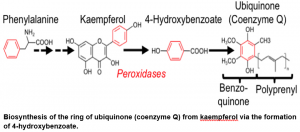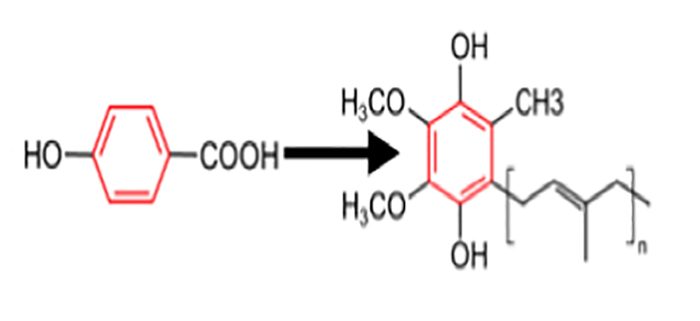Ubiquinone (Coenzyme Q) Biosynthesis in Plants: Free that Ring
Soubeyrand et al. use genetic and biochemical evidence to show that Arabidopsis and tomato can derive the ubiquinone precursor 4-hydroxybenzoate from the B-ring of kaempferol. Plant Cell https://doi.org/10.1105/tpc.18.00688.
By Eric Soubeyrand, Timothy S. Johnson, and Scott Latimer, University of Florida, Gainesville.
Background: Ubiquinone (coenzyme Q) is a vital cofactor required for cellular respiration and for the protection of biological membranes against free radicals. It is made up of a ring-like structure -called benzoquinone- and a long carbon chain -called polyprenyl (Figure). Finding out how plants make ubiquinone can help breed or engineer crops that are more stress-resistant and have increased nutritional value.
Question: Previous work from our group has shown that plants possess the unique ability to synthesize the ring of ubiquinone from the metabolism of the amino acid phenylalanine. However, the mechanisms by which phenylalanine is incorporated into ubiquinone is not fully understood.
 Findings: Combining bioinformatics, heavy-isotope labeling and ubiquinone analysis in a series of Arabidopsis and tomato mutants, we showed that plant cells are able to synthesize the ring of ubiquinone from the cleavage of a compound called kaempferol, itself derived in part from phenylalanine (Figure 1). Furthermore, enzyme assays demonstrated that such a cleavage of kaempferol is catalyzed by a class of enzymes called peroxidases. We also provided evidence that the ubiquinone content of tomato fruits can be increased via the up-regulation of kaempferol biosynthesis.
Findings: Combining bioinformatics, heavy-isotope labeling and ubiquinone analysis in a series of Arabidopsis and tomato mutants, we showed that plant cells are able to synthesize the ring of ubiquinone from the cleavage of a compound called kaempferol, itself derived in part from phenylalanine (Figure 1). Furthermore, enzyme assays demonstrated that such a cleavage of kaempferol is catalyzed by a class of enzymes called peroxidases. We also provided evidence that the ubiquinone content of tomato fruits can be increased via the up-regulation of kaempferol biosynthesis.
Next steps: Plants are able to block the cleavage of kaempferol via formation of sugar adducts. Our next step is to find out what the enzymes responsible for the formation of these adducts are, so the corresponding genes can be inactivated using gene-editing technologies. It is expected that the resulting knockouts would be freed from any constraints on the cleavage of kaempferol, and thus display a large increased in ubiquinone levels.
Eric Soubeyrand, Timothy S. Johnson, Scott Latimer, Anna Block, Jeongim Kim, Thomas A. Colquhoun, Eugenio Butelli, Cathie Martin, Mark A. Wilson, Gilles J. Basset. (2018). The Peroxidative Cleavage of Kaempferol Contributes to the Biosynthesis of the Benzenoid Moiety of Ubiquinone in Plants. Plant Cell 30: 2910-2921; DOI: https://doi.org/10.1105/tpc.18.00688
Key words: Ubiquinone, Flavonoid, metabolism




